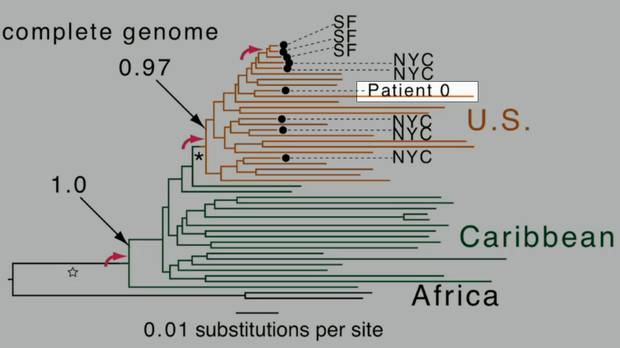A genetic analysis of decades-old viral samples has corroborated the growing evidence that the Canadian flight attendant Gaétan Dugas was wrongly labelled as the "Patient 0" responsible for the start of the AIDS epidemic in North America.
The latest findings were presented recently at a conference and first reported by the magazine Science. It is based on samples collected in the 1970s in the United States. Those samples were compared with the genome of HIV virus found in Mr. Dugas.
"The bottom line is that there is nothing special about his genome. No indication that this patient was the index patient of the entire pandemic," Michael Worobey, an evolutionary biologist at the University of Arizona, told the conference.
A Canadian scientist who has used gene sequencing to document the emergence of HIV, the virus linked to AIDS, Prof. Worobey spoke on Feb. 25 at the Conference on Retroviruses and Opportunistic Infections.
The research has not been published yet, he said.
He said he looked at serum samples collected in 1978-79 in San Francisco and New York City.
He wanted to determine the genetic history of the HIV-1 group M subtype B, the main genetic form of the virus linked to AIDS in the Americas.
The researchers had recovered near-complete genome sequences from eight patients.
In addition, the researchers were able to examine a sample from Mr. Dugas, who took part in a 1982 study by the U.S. Centers for Disease Control.
The genetic diversity of those HIV-1 strains showed that "these things were not new on the scene," Prof. Worobey said.
In an abstract of his presentation, Prof. Worobey said the latest data supported the idea that the disease spread through a single virus that moved from Africa to the Caribbean around 1967, then to New York by 1971 and later to San Francisco by 1975.
"In the context of these insights into the early spread of HIV/AIDS in North America, the genesis and persistence of beliefs about 'Patient 0' … are unsupported by scientific data, …" the abstract said.
Born in Quebec City, Mr. Dugas was a gay Air Canada flight attendant who was very sexually active as he travelled around the continent in the late 1970s. He died in 1984.
In recent years, historians such as Richard McKay at University of Cambridge and Phil Tiemeyer at Philadelphia University have also refuted the myth that Mr. Dugas was the original AIDS patient.
In a 2014 article in the Bulletin of the History of Medicine, Dr. McKay described how the portrayal of Mr. Dugas was shaped by And the Band Played On, the 1987 book by the gay journalist Randy Shilts about the arrival of AIDS in the United States.
According to Dr. McKay, Mr. Shilts did not know Mr. Dugas' identity when he started writing his book, but was looking for a way to personify the spread of the epidemic.
Mr. Shilts eventually identified Mr. Dugas as one of the patients in the 1982 CDC study that looked at a cluster of California cases and provided the first persuasive evidence that a sexually transmissible agent caused AIDS.
The study focused on how the disease was transmitted, and did not aim to determine who was the first person in the Americas to have AIDS. In it, Mr. Dugas was identified as "patient O" –the letter "O" indicating he was from outside California – but the label evolved, and the letter was turned into the number "0."
Describing Mr. Dugas as a charming, promiscuous man who had 250 sexual contacts a year, Mr. Shilts wrote about "the unique role the handsome young steward performed in the coming epidemic."
Mr. Shilts' publisher, St. Martin's Press, focused on Mr. Dugas in the marketing strategy for the book, resulting in lurid headlines in the mainstream media.
"There was," Dr. McKay wrote, "much more to Gaétan Dugas than Shilts and St. Martin's Press saw fit to print, and much more complexity to his experience than large swaths of the North American reading public cared to know."
Follow me on Twitter: @TuThanhHa

